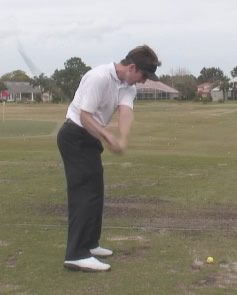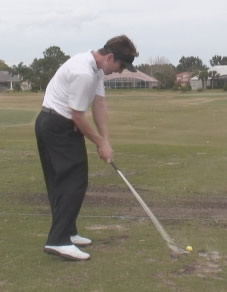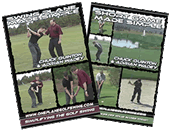by Chuck Quinton
Rotary Golf Swing - Rhythm in the One Plane Swing |
Rotary Swing Golf |
![]() Watch Rhythm and Flow in the Golf Swing Video
Watch Rhythm and Flow in the Golf Swing Video
Many golfers learning the one plane swing tend to neglect the rhythm aspect necessary in any golf swing. Ask any PGA Tour professional what role rhythm plays in their swing and you will get the same answer - they're always working on it. That's how important rhythm is. While timing is not as critical in the one plane swing while compared to the two plane swing, rhythm is the glue that holds any golf swing together. Unfortunately, the way the golf swing has been taught for decades has made it impossible for any golfer to learn rhythm because they are too fixated on positions in the swing. The swinging motion of the club is a thousand times more important than the positions of the club. The club must be allowed to flow throughout the swing and "go through" the proper positions rather than be manipulated into those positions. Even more interesting is that swinging the club with a sense of rhythm is more apt to allow the club to flow through the proper positions on a much more consistent basis than trying to manipulate the club into position throughout the swing.
So, how does one work on rhythm? I have a couple tools that I use that help me when my rhythm is off. The first one, and one of the most important, is visualization.
Visualization
When I speak of visualization and flow in the golf swing in the same breath,
I am generally referring to "seeing" a golfer with great rhythm
in your mind's eye and imagining his or her swing. With a good visual of a
golfer's swing with great rhythm, your mind then has a much more clear road
map of the type of swing that you are asking it to produce. Visualizing golfer's
such as Annika Sorenstam, Ernie Els or Vijay Singh while practicing can literally
work wonders in your golf swing. I've seen it hundreds of times and I use
it myself when my rhythm gets a little lost. So the next time you are at the
range, visualize the grace and elegance of Ernie Els' effortless golf swing
and allow your mind to reproduce the movements. Swing with good tempo and
rhythm and see how your swing comes together.
Flow Drill
This is a great drill that will require your body to flow throughout the golf
swing, but when done correctly, you will marvel at the quality of the strike
and the effortless power you will produce. The body is so much more graceful
when starting from non-static positions, but unless you want to Happy Gilmore
all your shots, you're likely going to be starting from a fairly staic address
position. To help "get your body movin'", this flow drill is a great
one to bring your swing to life. To start, take your normal setup position
with a short to mid iron (I used a 5 iron in the video demonstration). Once
you are comfortable, raise up out of your address position just enough so
that the club can clear the ball as you swing the club forward several feet
into your follow through position. From here, "let" the club flow
back all the way to the top of your swing and then swing down with the same
sense of rhythm. There is absolutely no need to be concerned with positions
of the club at any point during the swing, the main things you are looking
for is a sense of rhythm and flow as the club flows back throughout the swing
and solid contact with the ball. Work with this drill until you can make solid
contact repeatedly. If you happen to video tape yourself, pay close attention
to how free your body should be to swing the club and how effortlessly you
build up clubhead speed. You may find that your swing flows a bit more to
the inside and gets a little long at the top, this is perfectly ok as your
body is simply uninhibited and is making a completely free swing. Again, don't
be concerned with any positions, you are simply wanting to instill a good
sense of rhythm and flow and this drill is a great help, especially for one
planers who tend to get a little tense and quick.
Making a Full Turn when Playing a Round
When a golfer's rhythm starts to get off during a round, they are almost always
are getting quicker, particularly with the arms and upper body, causing these
muscles to tense up and shorten, and thus their swing shortens and loses much
of its natural flow and the golf "swing" and turns more into a desperate
"hit". To combat the natural tendency to get quick and shorten the
swing as the round progresses, work with this rhythm and flow drill before
each shot to give your body a great reminder of how free and effortless the
golf swing really can be. Remember, you can have less than perfect mechanics
and still hit perfect golf shots with good rhythm and flow but the great mechanics
and poor rhythm and flow will do you little good. The pros have known this
secret for a very long time, now you know as well.
The only time that really matters
While a great deal of time can be spent discussing swing theory, the bottom
line is that the only time that matters is impact and the path you use to
get there. Having good rhythm and flow allows you to repeat the proper path
to the ball and impact positions consistently more so than anything else.
Even though my swing is more around and long when using this drill than during
my normal swing, my downswing and impact positions are ideal, with the club
coming right through the middle of my right forearm in the first picture.
In the second picture, I'm coming from the inside with my right elbow still
back behind my right hip, which is still clearing. At impact, my right forearm
and shaft are in perfect alignment and my right elbow is still behind my right
hip. As you can see, it matters only to a degree how you swing the club back
in regards to positions, but if you let the swing flow on the way down rather
than trying to force the issue, you can let the club do most of the work and
end up in the proper positions.



|
|
|
| ||||||||



